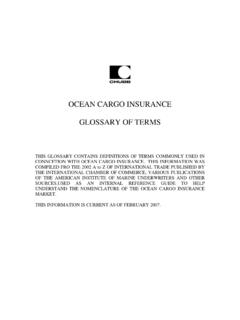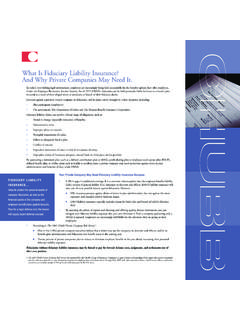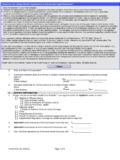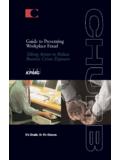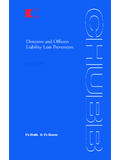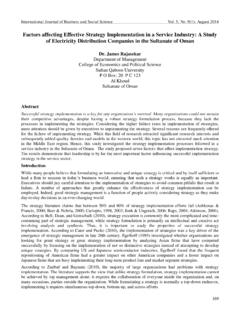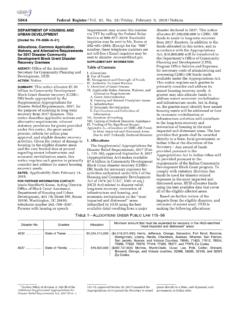Transcription of Vol. 9, No. 2, February 2013 Happy Trials to You
1 Vol. 9, No. 2, February 2013 Happy Trials to You . Global Clinical Trial Liability Insurance By Frank Goudsmit Clinical trial liability insurance is a critical, yet sometimes misunderstood, element of the clinical research process. All key stakeholders institutions, investigators, contract research organizations (CROs), sponsors, institutional review boards (IRBs)/ethics committees (ECs), and trial participants can find themselves perplexed by the complexity of insurance and frustrated by the challenge of effectively choreographing a global insurance program. This article's aim is to help develop a deeper understanding of: the framework within which global Trials should be insured, the scope of insurance coverage available to key stakeholders, how indemnification provisions between various parties should be designed, and how the clinical trial insurance process can be managed for maximum efficiency, affordability, insurance protection (both to balance sheets and human subjects), and ease of administration.
2 Sponsor Product Liability/Human Clinical Trial Liability Insurance Although this article will address clinical trial liability insurance from the standpoint of the sponsor, the policies issued on their behalf are of interest to all stakeholders, since the sponsor's policy supplements the sponsor's own financial resources and may offer indemnity or additional insured status to other parties. Even with excellent protocol design and thorough preclinical research, exposure to an investigational product in a clinical trial presents bodily injury risk to participants and, through legal proceedings and judgments, financial and reputational risk to all trial stakeholders. Such risks, while unavoidable, can be mitigated or transferred through a well- designed insurance program. To illustrate how a global clinical trial insurance program can be structured, consider a hypothetical sponsor who is planning a 27-month trial in six countries: the United States, France, Germany, Poland, Argentina and New Zealand.
3 Such a multinational trial would generally be insured under a combination of policies, including: The sponsor's master product liability/human clinical trial liability policy One or more admitted or local insurance policies, which consist of policies issued by insurance companies that are licensed to transact business in the countries where the trial is taking place; in some instances, local insurance is required by regulation;. however, it may also be desirable to purchase this type of policy to be responsive to market practice or sponsor or business partner preferences In the hypothetical example above, the insurance program might be structured as follows: For participants enrolled in clinical. Trials in the and New Zealand (which does not require admitted policies), insurance is provided through the annually renewable master policy. For participants in French, German, Polish and Argentinian clinical Trials , coverage is provided through the issuance of four separate policies, one in each country.
4 Each policy would be issued by a locally licensed insurance company, in the local language Subscribe free at 2013 First Clinical Research and the Author(s). and with limits of insurance in the local currency, on a good local standard (market standard) coverage basis. Each of these policies would be issued for the expected 27-month term of the trial. A key distinction between the two types of policies is that only the master policy will be renewed annually. If the clinical trial takes longer than expected, the locally admitted policies would be extended. For this reason, when clinical Trials are insured under the master policy, to ensure that insurance for these Trials will remain in force for the full duration of the protocol, ethics committees should confirm that the master policy has been renewed as required. In this example, one challenge for the sponsor's risk manager or chief financial officer is how to accurately assess the scope of insurance for the four admitted policies, especially since they are written according to local practices in four different languages: French, German, Polish and Spanish.
5 In contrast, the master policy is written in English according to practices, so the sponsor and its insurance agent or broker more readily understand its scope. To help prevent possible gaps in insurance protection under the admitted policies, sponsors should seek differences in conditions (DIC) insurance, a feature that can be included under the master policy (typically as part of a liability global extension). DIC insurance will respond to claims that are insured under the master policy, but excluded under the admitted policy. For example, the standard German clinical trial insurance policy excludes non-economic damages, so allegations of pain and suffering in a clinical trial liability lawsuit in Germany would be excluded under the admitted policy, but could be insured under the master policy via the DIC provision. The limits or amount of insurance available under admitted policies reflect local regulations and practices.
6 While a sponsor might have $10 million limits of insurance under the master policy, the admitted policies could have far lower limits of insurance, such as 100,000 or about US$133,000 per participant (at current exchange rates) and 500,000/US$665,000 in the aggregate for all claims from a single protocol. How can the sponsor be protected from higher-value claims in foreign jurisdictions? The insurance industry response to this challenge is differences in limits (DIL) insurance. To illustrate by example, in the event of a 2 million settlement against the sponsor for injuries sustained by a single claimant in a country where the admitted per participant limit of insurance is 100,000, the admitted policy would pay its limit, and the million balance could be insured under the master policy via the DIL provision. Many countries have compensation guidelines that sponsors are asked to follow. Sometimes referred to as no-fault provisions, these guidelines include the Association of British Pharmaceutical Industry Compensation Guidelines, as well as similar guidelines in Australia, South Africa, and other countries.
7 Sponsors should ensure that their master policies confirm the insurer's willingness to initiate claim settlements in accordance with such guidelines. If the claimant is dissatisfied with the settlement offer from an arbitrator, sponsors may be sued for higher sums, so the master policy should also have a legal liability backstop to respond to such claims. A collectability provision is the final critical insurance feature sponsors should seek under their master policies. Generally, this feature responds if an insured claim is submitted to a foreign insurer but proves uncollectible. With this feature, the insurer of the master policy could step in to pay the insured claim. If a sponsor's first clinical Trials take place overseas, it sometimes makes the mistake of purchasing only an admitted policy the bare minimum insurance required to allow the Trials to proceed. In the absence of a master policy, none of the features Subscribe free at 2.
8 2013 First Clinical Research and the Author(s). highlighted above would be available. For this reason, even when a sponsor's first clinical trial exposure is overseas, it is highly advisable to put both an admitted policy and an annually renewable master policy in force at the same time . Certificates of Insurance for ECs and IRBs Certificates of insurance in the local language detailing the clinical trial's key features are a prerequisite for EC/IRB approval. However, changes to these details often occur right up to the scheduled EC/IRB meeting date, creating the risk that approval might be delayed due to the inability to produce the required insurance documentation in a timely manner. With many ECs/IRBs meeting infrequently (often monthly or even every other month), long delays can lead to millions of dollars of lost revenue as the clock ticks on the compound's period of patent exclusivity. Some common modifications that require re-issuance of insurance certificates include: A change in the estimated number of participants Modifications to the protocol title Additions or deletions of clinical investigators (in countries where they must be listed).
9 Typographical errors To minimize this risk, some insurance companies offer an online system to automate the issuance or modification of certificates. With such a system, a sponsor, its insurance agent or broker, or its contract research organization can be empowered to make the necessary modifications and secure new documentation instantaneously. Additional-Insured Provisions and Liabilities Although all players in the clinical trial process must secure insurance for their own negligence, it is reasonable for contractual agreements to provide that certain parties will indemnify and defend other parties under some circumstances, for example: A clinical investigator who dutifully follows the protocol as designed by the sponsor and who is nevertheless sued for injuries sustained by a trial participant should expect the sponsor to defend and indemnify him or her from such claims. A CRO who agrees to act as the local legal representative for a non-European sponsor of a European clinical trial should expect the sponsor to indemnify it for liabilities it incurs by assuming that responsibility.
10 It is therefore important for the sponsor's master policy to have broad additional-insured wording. Ideally, this clause provides additional-insured status for any person or organization contractually engaged to provide service, advice or instruction in connection with the clinical trial, without the requirement to specifically name the entity in the policy. Care should be taken, however, not to assume liabilities beyond the sponsor's legal liability. For instance, no indemnity should be offered by a sponsor for the negligence of others, such as: A clinical investigator who violates the protocol by enrolling subjects who were clearly not eligible under the inclusion criteria of the trial A CRO that fails to uncover evidence of serious regulatory non-compliance or fraud by clinical investigators Subscribe free at 3. 2013 First Clinical Research and the Author(s). The sponsor could still be sued for inadequate oversight in these situations, but the sponsor's insurance coverage should not be used up by defending and indemnifying the parties who are legally liable.


